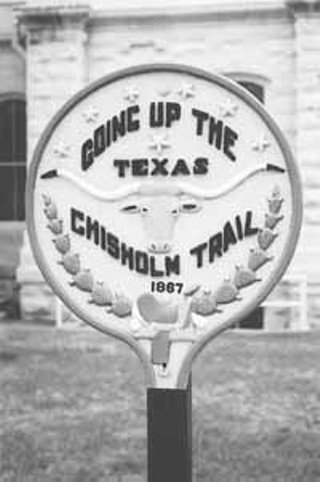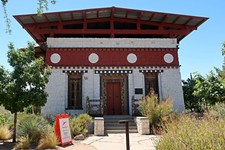Day Trips
By Gerald E. McLeod, Fri., Nov. 8, 2002

The Chisholm Trail served as a principle transportation route for a little more than two decades, yet it has become as much a symbol of romantic Old West as cowboys, six-shooters, and dance halls.
After the Civil War, great herds of unbranded cattle wandered the uninhabited lands of South Texas. Returning veterans quickly recognized a business opportunity. Bovines purchased for as little as $1 or rounded up for free in Texas could be sold in the northern railroad towns for as much as $40 a head. Fortunes were made and lives were lost driving millions of cattle 560 miles from Central Texas to southern Kansas where they were shipped to the slaughterhouses of Chicago.
The Texas Historical Commission has produced a free brochure, "The Chisholm Trail, Exploring the Folklore and Legacy," outlining the cattle trails that thousands of cowboys rode from Brownsville to the Red River. The pamphlet highlights 41 towns that were affected by the cattle trade between 1867 and 1887.
The main trail roughly followed modern-day I-35 from San Antonio to Fort Worth where it branched off to the west on what is now U.S. 81 to cross the Red River near what is now marked on most maps by Spanish Fort, Texas. Few visible remnants remain of the trail other than cast-iron signs erected to commemorate the state's centennial in 1936 and a few historical markers.
Folks north of the Red River argue that the southern tip of the Chisholm Trail ended at a long-abandoned natural crossing called Red River Station. From here the trail followed the topography to Kansas. The natural route had been used by migrating buffalo, Indians, and military patrols but was given Jesse Chisholm's name because he once used the route to transport goods and cattle to and from his Indian trading post on the Canadian River in Oklahoma.
Chisholm was born of a Scottish father and a Cherokee mother in Tennessee before moving west where he was an Indian trader, interpreter, and guide for most of his 63 years. He worked for a time in San Antonio and Waco, for the Republic of Texas, trying to make peace with the prairie Indian tribes. He died in 1868, three years after the trail became known as "Chisholm's Trail."
Texans claim bragging rights to the Chisholm Trail because several feeder trails crossed the state and converged on the main trail at Red River Station. The argument can be made that since the cattle herds started in Texas and ultimately were headed for the Chisholm Trail, these branches are legitimately part of the trail.
It is unarguable that the sale of beef was an important part of the economy following the War Between the States. Longhorn cattle made fortunes and legends for ranchers like Shanghai Pierce and Richard King. King's ranch would expand to be larger than the state of Rhode Island.
For the common Texas farmer, the cattle drives were a source of much-needed income. The sodbuster could plant his crop in the spring and then hire on for a cattle drive. The $40- or $50-a-month in pay bought much needed supplies. If he didn't get killed in a stampede, drowned in a flood, or shot by Indians or robbers, then his crop would be nearly ready for harvest when he returned home three months later.
Towns like Kerrville, Johnson City, and Lockhart grew up around staging areas where herds were assembled and then headed north. In Spanish Fort, Joe Justin would take the measurements of the passing drovers and have a new pair of boots waiting when the cowboy returned on his way home. The family business grew into the Justin Boot Company.
By 1876, most of the northern cattle drives shifted west of Wichita Falls to cross the Red River near present-day Vernon. By 1887, the great cattle drives were blocked by barbed wire and quarantines and replaced by railroad tracks.
A free copy of the Chisholm Trail brochure is available at most visitor centers or from the Texas Historical Commission; call 463-6255 or visit their Web site at www.thc.state.tx.us.
596th in a series. Day Trips, Vol. 2, a book of Day Trips 101-200, is available for $8.95, plus $3.05 for shipping, handling, and tax. Mail to: Day Trips, PO Box 33284, South Austin, TX 78704.








